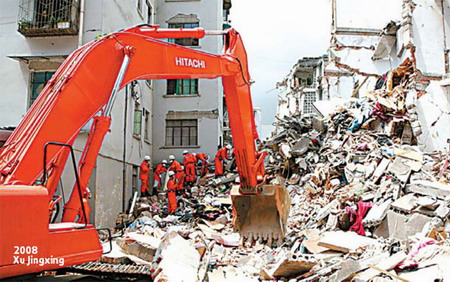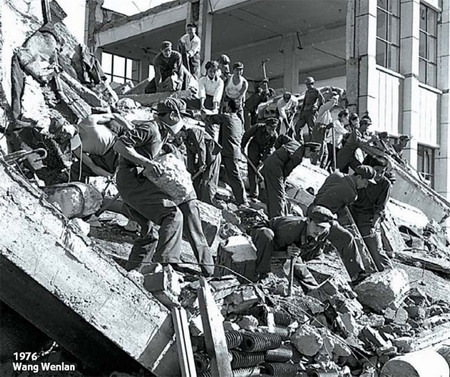
|
BIZCHINA> Wen's Lens
 |
|
Related
The task ahead
By You Nuo (China Daily)
Updated: 2008-06-09 17:16
  Victims of the recent Sichuan earthquake are laying the ground for rebuilding their lives. With soldiers and volunteers from all over the country, they are knocking down the dangerous old buildings, clearing up the debris, and starting to rebuild - first with makeshift residential quarters, and then to implement the plans for new cities. The current color photo, taken by China Daily photographer Xu Jingxing, shows how this is going on in the quake zone. Our 1976 black-and-white photo, taken by Wang Wenlan, shows rebuilding in Tangshan following the quake there.
 On June 3, the State Council, or the Chinese cabinet, commissioned the feasibility study for long-term redevelopment of the quake zone. To be sure, rebuilding cities in an earthquake zone is never easy, but rebuilding in Sichuan is going to be particularly difficult if all the people who lost their homes are to be resettled in their old locales and lifestyles. There will be daunting challenges and the overall task is huge. The Chinese press reports that there are at least 5 million of them, and the number of homeless could be as high as 15 million. Second, there is a time pressure. Neither the government nor the general public can allow people in the quake zone to spend years in tents or other temporary dwellings. After the Tangshan earthquake in 1976, some people could not move into their new houses for close to 10 years. But so much waiting is inhumane and with a much stronger economy now, China must provide the victims with the proper housing arrangements as quickly as possible. Third, it is almost impossible, and too dangerous in some cases, to rebuild the collapsed cities and towns on their original sites. Former residents of some cities and towns on the fault line will have to be relocated to safer places. The government has yet to tell us how many people will have to be resettled. Judging from the past experience, the largest government-sponsored relocation program for the Three Gorges Dam project involved only 1 million people. Presumably, the future Sichuan relocation program will include many more people. Fourth, a new land development model will have to be introduced. In China - let alone Sichuan - it is already impossible to find new land resources for relocating up to 15 million homeless people if they are to remain farmers. The new cities, no matter where they are to be built, will have to be of considerable size and able to provide their residents with suitable jobs. Only cities can use land resources more economically and generate a larger variety of jobs and opportunities for the locals. That task would be like relocating almost the entire population of Florida and putting all of them into one or several cities. This is something that neither Beijing, nor any government in the world, has ever done before. But China has no dearth of experience in building cities in a few decades' time. It has been building new cities through its reform era - like Shenzhen and Zhuhai in the 1980s, Shanghai's Pudong in the 1990s, Tianjin's Binhai and Tangshan's Caofeidian in breathtaking speed. Wherever the government is willing to give a full play to the private sector's initiatives, there is more rapid urban development.
(For more biz stories, please visit Industries)
|
主站蜘蛛池模板: 博罗县| 平远县| 西乌珠穆沁旗| 滦平县| 巍山| 延寿县| 集安市| 东乌珠穆沁旗| 突泉县| 抚顺市| 广西| 星座| 湾仔区| 申扎县| 绵竹市| 郓城县| 塔河县| 伊宁市| 芜湖县| 宝坻区| 太谷县| 巩留县| 宁津县| 阳高县| 岑巩县| 金乡县| 逊克县| 隆子县| 永春县| 阳城县| 阳春市| 乌鲁木齐县| 萨迦县| 达拉特旗| 深圳市| 金寨县| 台东县| 延寿县| 沈丘县| 玛曲县| 乌海市|